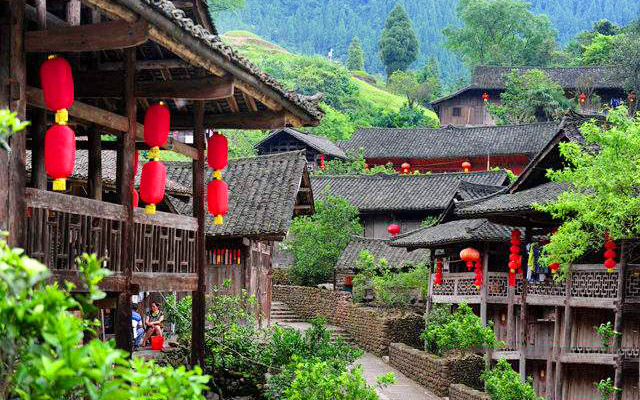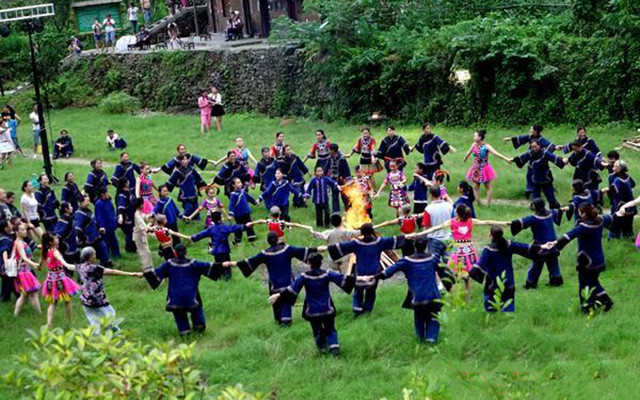Xiangxi Laosi City: Collection of Tujia Culture
In Yongshun, Xiangxi, there is a mysterious place called Laosicheng, which was the royal city of ancient tusi. What is special about Laosi City? Below, I will reveal the mystery of Laosi City to everyone.

Yongshun County, where Laosi City is located, formerly known as Xizhou, is one of the important birthplaces of the Tujia ethnic group. It is known as the "hometown of waving hand dance" and the "hometown of Maogusi dance". Its ethnic cultural heritage is profound, mysterious, unique, and has a long history. Amidst the ruins of Laosi City, lies a breathtaking archaeological site spanning decades and a fascinating 800 year mysterious history.

As the saying goes, 'With mountains as barriers, water becomes a pool.' Laosi City not only has a rich history, but its cultural connotations and natural scenery complement each other. The city is quaint and weathered, while the city is surrounded by mountains and rivers outside. The authentic Tujia folk customs passed down from generation to generation by the people of Laosi City, such as Maogusi dance, hand waving dance, Tujia New Year, and dancing, also give this city a unique vitality.

When it comes to tusi culture, most people may only have a basic understanding. It was used by the ruling class of feudal dynasties to solve ethnic policies in the southwestern minority areas. Yongshun Laosi City is the administrative center of the Peng tusi regime in Guxi Prefecture, and its ruins are currently the largest, most well preserved, and oldest ancient tusi city ruins in China. Walking in Laosi City, ruins and ruins are all silently telling the history of the prosperity of the 800 year Tusi Dynasty.

The Laosicheng site is divided into three areas based on the three-level terrain: residential area, yamen area, and leader's living area, with a chessboard layout of "three vertical and five horizontal". There are eight streets: He Street, Zuo Street, You Street, Zheng Street, Banpo Street, Wutun Street, Yudu Street, and Dongmen Street.

The streets are decorated with patterns made entirely of reddish brown patterned pebbles, which have ethnic characteristics. These patterns vary with the terrain and are quaint and elegant. Firstly, the culture of Laosi City.

Ancestral Hall: This hall covers an area of over 580 square meters. The main hall has a width of five rooms and a depth of four rooms, with a double eaved gable roof. It is 17.5 meters long, 13 meters wide, and 20 meters high, and is made entirely of wood. The roof is supported by 34 large columns.

Tusi Dezheng Stele: The Tusi Dezheng Stele is erected on the left side of the site of the Sicheng yamen and is carved from bluestone. The monument is 2.74 meters high and 1.2 meters wide, with inscriptions on the abdomen and back. It is topped with a stone cap and supported by stone pillars.
Enthusiasm and hospitality are traditional customs of the Tujia ethnic group, and these experiences cannot be ignored.

Maogusi Dance: In Tujia language, Maogusi Dance is called "Gusipapa Dance". It originated from the sacrificial ceremony of the Tujia ethnic group and is an ancient form of theatrical dance of the Tujia ethnic group in western Hunan. Featuring characters, dialogues, simple storylines, and certain performance routines, such as "dewdrops", "sweeping in and out", "hunting", etc.

Waving Dance: It combines song, dance, music, and drama, depicting a wide and rich history and social life, including the creation of the world, human reproduction, ethnic migration, hunting and farming. The swinging and dancing movements are generous and rough, including single swing, double swing, spiral swing, and jumping while swinging.

Daliuzi: This is the most widely spread ancient folk instrumental ensemble in the Tujia ethnic region, with a variety of musical instruments, exquisite skills, and rich expressive power. It is a unique art form of the Tujia ethnic group and closely related to the lives of the Tujia people.
Laosi City has important historical value and profound practical significance. Visiting Laosi City, searching for the past and reflecting on the present, can't help but feel a surge of excitement!
Previous Article:Thick Tujia sentiment in 'Smoke and Rain Zhangjiajie'
Next Article:The unparalleled wonder - Huanglong Cave
